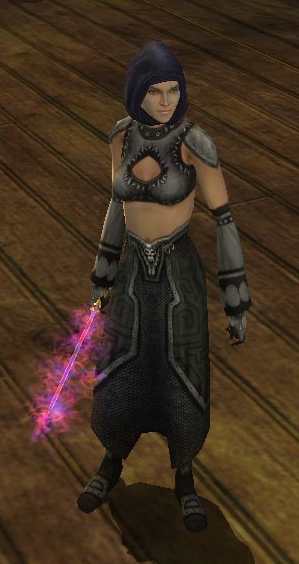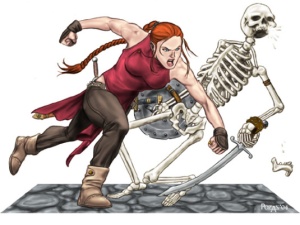I’m straying again from monastic enlightenment, but primarily because I’m fond of Rogues, their complementarity with Ninja Spies, as well as my total love of stealth operations, recently codified for others.
There’s also the matter of refining what I’ve learned from my aging first-life Acrobat, Allysen, combining my stealth teachings from Kiricletica and others.
Say hello to Sukitetica. She’s a halfling Assassin, inspired by Log Horizon’s cute but deadly character, Akatsuki.
With Suki, my goal is to destroy my own fallacies about any limitations in the class. But Update 22 won’t make that easy.
The Art of Offensive Non-Aggression

Enjoying the Splinterskull throne. It’s lonely being an Assassin–and Sukitetica likes it that way, mostly.
Unlike Ninja Spies, Rogues, in general, have high to-hits but not necessarily high damage per attack. By the basic design, Rogues gain a far greater attack when enemies aren’t paying attention to them: Sneak Attack.
The benefits of Sneak Attack damage in stealth ops returned quickly to my attentions after only a few minutes with Suki.
When running Kiricletica during her self-imposed solo challenge days, I had to refresh myself about Threat.
Also known as “Hate” or “aggro”, Threat is a calculation by an enemy AI on how much damage it suffered from your character, even if you’ve not actually caused any damage. The Intimidate skill exploits Threat to pull enemies to tanking characters.
For Kiri, I managed Threat simply by avoiding attacking except when required. Even if attacked, I used attacks and gear that caused a momentary Bluff effect, where a target briefly turns their attention away from you, reducing their number of attacks on you.
The goal of an Assassin is to keep their Threat as low as possible while still keeping an aggressive posture. If Threat goes too high, not only will the enemy choose you as a target but it eliminates your chance to deal catastrophic damage by Sneak Attacks, the hallmark trait of fighting Rogues.
To their credit, Ninja Spies also gain Sneak Attack enhancement training identical to Rogues. However, Rogues gain class bonuses to Sneak Attack as auto-granted feats as they level, substantially increasing damage over any other class Sneak Attack powers. Being a Halfling, like Suki, affords a chance to train additional Sneak Attack dice on top of Rogue levels and Assassin tree enhancements.
So, to best manage Threat, Suki’s learned to always hire a meat shield and set him or her to fight.
Often, she chooses Clerics as they also have restorative powers, self-healing, and a fair amount of defenses. Such hirelings (or summoned creatures they can add to a battle) needn’t endure being surrounded for long. Lurking in stealth, Suki sends her mercenaries ahead to attract as many enemies as they can withstand.
Then she strikes the grouped enemies from behind. Using Single Weapon Fighting and combined with Dexterity-to-hit and to-Damage bonuses, she gains improved weapon damage. Kukris are preferred over daggers but Suki uses what tool is best, depending on the enemy. She holds onto a Muckbane for the oozes.
Combined with a strong weapon, Suki carves through her foes with swift, lethal precision. Even at her current level 8, armed with a highly damaging Blood Machete with level 8 Frost and Fire augment gems, anything that isn’t undead or a construct meets a very sudden end.
Exactly What It Says On The Tin
Anyone who forgets why Assassins exist, and who refuse to assist them in gameplay, epically fail to comprehend the very clear role of this class tree. A ninja can assassinate, but requires greater training (level 16). The Monk’s Quivering Palm attack does instantly and quietly kill a target (with a sufficient WIS DC) but it pulls the attacker out of Sneak.
The Assassin’s quintessential attack leaves the Assassin in Sneak and undetected.
But Suki is several levels from training the Assassinate ability–not that it works too well with Update 22. An overbalancing problem with enemy AI causes them to sense the Assassin after a quick kill. Bluff is also bugged, attracting enemies that aren’t targeted.
Thankfully, according to a report from Master Assassin Nokowi, Update 23 appears to rectify the issue, restoring the one skill and related Roguish powers.
Until she reaches Level 12, Suki is content to leverage other special attacks in her arsenal. There are three “poison” attacks. In truth, these are debuffing attacks which aren’t enhanced by Poison vulnerability effects such as those from the Ninja Spy’s Ninja Poison. Despite this, these so-called “Poison Strikes” can debuff enemy saves, increase damage, decease spell resistance or even paralyze under the right conditions. By “right,” I should say rare. Most of these go off only on Vorpal attack rolls.
Still, spamming these three attacks, in addition with Bleed Them Out and Shiv, both with increased weapon damage, aren’t a bad combination at all to ensure that whatever you attack is deader than dead in only 1 or 2 attacks.

Suki had to go with an “Assassin’s Creed” look. Nope, never played that game. But their avatars look stellar.
Suki is training her stealth master skills but is quite the opposite of the low-kill edict of Kiricletica. Suki is, effectively, blood-thirsty. She knows her objectives as well as vulnerabilities and would rather take them out and not butcher an entire dungeon needlessly at greater risk to herself and her party.
She’d ask you to define “needlessly,” however, since enemies are in her way to her central objectives, loot and the exit. Seems that there will be few times where Suki doesn’t feel threatened. An Assassin, it seems, may be one living, death-dealing definition of paranoia. They do believe everyone is out to get them, and thus prepare themselves to counterstrike before her enemies can make a single attack.
As opposed to some anti-social ninjas you know, Suki would love to join her guildmates or even PuGs. She’s also an excellent trapmaster and lockpicker, and appreciates the fine work that other party members do in attracting attention so she can eliminate the tougher enemies without interference.
The challenge is ensuring that party members allow Suki to do her job. Assassins require cooperation of others to thrive.
Compensating for Lost Ki
I’m already missing two characteristics of the Ninja Spy: the Wholeness of Body self-healing feat, and Shadow Veil, a level 6 ninja enhancement that grants one minute of invisibility and 25% incorporeality at will (for 10 ki).
Happily, I have some options.
This time I’m listening to Sir Geoff of Hanna regarding dragonmarks. Suki’s got her Mark of Healing. While eventually having a reserve of Heal is a good thing, it’s Break Out the Leeches that makes me giddy.
It removes a negative level, disease and poison effect stack once every 3 seconds. Leeches work per your Heal skill: If you have 10 in Heal, the leeches go to work for 10 seconds. Clearly, I’d like to have at least 12 Heal, more if possible for this cross-class skill.
I’ll miss the ki-based self-healing of a Monk less with these dragonmarks. Maximizing the Jorasco Dragonmark Focus adds a bit more versatility with more dragonmark uses and bonuses to Heal, per The Geoff.
As far as invisibility goes, I tend to stockpile Potions of Invisibility as I find them in quests. Suki carries several dozen. I shouldn’t need them as often if I invest a few additional points in both Halfling and Rogue versions of the Stealthy enhancements to substantially increase Suki’s Hide and Move Silently abilities. She’s trained Faster Sneaking from the Mechanic tree. and wears the faster Speed or Striding gear.
Suki is training her Use Magic Device skill in hopes of using Invisibility scrolls (UMD: 24) and other spells later in life. Such items can be problematic in the wilds as some have verbal components–you make sounds as you use them. That’s bad for someone that doesn’t want to attract attention.
I’m new to UMD. I’ve generally been an opponent of this skill since I mostly play Monks, for which it is a cross-class skill. But I see the great advantages of a high UMD skill that will eventually add in emulating a few monastic powers I’m missing (such as Blur) but several others I can never attain as a mere Monk, such as Teleport, Raise Dead, Resurrection and Heal. The Mechanic line has 3 points I could grab, but that’s an expensive AP drain. I’d rather boost my CHA and take advantage of many other items to get my UMD to at least 40 by level 20.
Incorporeality of any serious degree beyond Ghostly will have to wait until she reaches Epic levels and enjoys Shadowdancer powers.
Suki is a simple girl. Provided she has a meat shield, no trap, no locked door, no enemy will interfere with her job.
I wish that the game could allow you to pair your character with a hireling avatar based from your character list. A hireling version of Kiricletica the ninja or Lynncletica the tanker paired with Suki would be formidable.





















Recent Comments